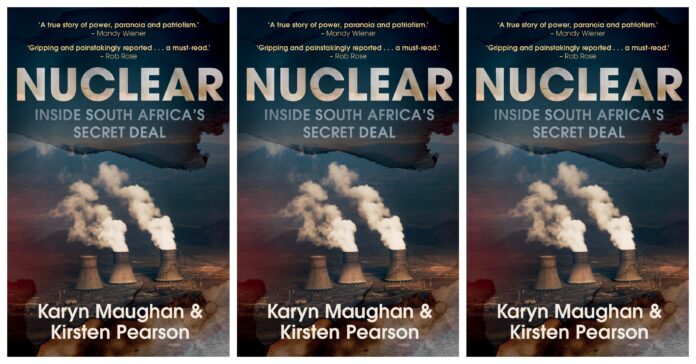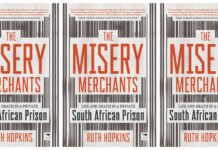Shortly after Zuma received treatment in Moscow for alleged poisoning, he signed off on a massive, far-reaching – and unlawful – nuclear power deal with Russia. Had this gone through, it would have devastated the South African economy. Award-winning investigative journalist Karyn Maughan and former National Treasury insider Kirsten Pearson reveal the full story for the first time. The nuclear dream may have been thwarted for now, but South Africa’s nuclear ambitions are still very much alive.
An extract from the book has been republished below.
Eight months before Earthlife and SAFCEI launched their challenge to the Russia–South Africa nuclear agreement, the Zuma administration made some radical changes to the leadership of the state-owned energy entity Eskom. Those changes, which were allegedly orchestrated by Zuma and his ally and confidante Dudu Myeni, have been strongly linked to the wholescale ‘capture’ and looting of Eskom by the Gupta family and their associates.
But the Zuma administration’s nuclear ambitions and the state capture project were intimately linked. The Zuma appointees who were inserted into the leadership of Eskom would become central figures in Zuma’s increasingly desperate campaign to push through a nuclear procurement process. That much is made clear by audio recordings and confidential minutes of Eskom board meetings, conducted between November 2016 and March 2017, that were obtained by us. These recordings and minutes clearly reveal how Gupta-aligned Eskom senior executives and board members did everything they could to push Zuma’s nuclear agenda.
The story of the shake-up at Eskom begins six months after Zuma and Joemat-Pettersson signed the manifestly unlawful inter- governmental nuclear agreement with Russia. On 8 March 2015 the Eskom board chairperson, Zola Tsotsi, met Zuma at his presidential residence in Durban. According to the testimony Tsotsi later gave to the Zondo Commission, it was Zuma’s confidante Dudu Myeni, chair of the South African Airways (SAA) board, with no formal role in Eskom’s operations and management, who phoned him the day before to arrange the meeting. His understanding, he said, was that the meeting had been requested by Zuma.
When he arrived at Zuma’s residence in Morningside, Durban, in the early afternoon, Tsotsi was met by Myeni, her son Thalente and Nick Linnell, a self-styled ‘legal advisor’ whom the Daily Maverick would later describe as ‘Myeni’s trusted hatchet man’. Tsotsi testified that, before his meeting with Zuma, Myeni told him that ‘there is a concern about the performance of Eskom, the technical performance and the financial performance of the company’.
She also claimed that there had been complaints that Eskom’s executives were failing to provide the government’s energy ‘war room’ – which was formed in December 2014 and led by Deputy President Cyril Ramaphosa – with accurate and timeous information.
The ‘war room’ had been set up after the Zuma government started implementing load shedding in March 2014, the first time the government had done so since 2007–8, when President Thabo Mbeki admitted that his administration had failed to heed Eskom’s warnings that there needed to be far greater state investment in the power utility’s generation capacity. In November 2014, the Majuba power plant in Mpumalanga, which delivered approximately 10% of South Africa’s entire capacity, lost its ability to generate power and as a result Eskom implemented planned blackouts from 5 December 2014, which continued between January and September 2015.
According to Tsotsi, Myeni suggested at their March 2015 meeting that an inquiry needed to be launched into Eskom’s failures. While that inquiry was proceeding, she added, Eskom CEO Tshediso Matona, head of capital projects and the ‘newbuild programme’ Dan Marokane, and head of technology and commercial Matshela Koko should all be suspended. All three occupied positions that would not only prove central to the Gupta network’s efforts to secure lucrative contracts at Eskom, but would also be pivotal to ensuring that the parastatal supported the procurement of nuclear reactors.
According to Tsotsi, Myeni contended that ‘the suspensions of the executives will not create difficulties because it will be explained that they are not accused of wrongdoing, but are being asked to allow space for the inquiry to proceed unencumbered by their presence’. Tsotsi said he was ‘totally shocked’ by Myeni’s proposal. ‘I was not opposed to the inquiry, but I was taken aback by the way the whole thing came about,’ he testified. ‘So, I was then at this point anxious that we should have this meeting that we were called for just so I can get a sense of really . . . what is going on.’
Tsotsi then went inside to meet Zuma, who began the discussion by asking in isiZulu: ‘What are we talking about today?’ According to Tsotsi, Myeni responded by stating that ‘the performance of Eskom financially and technically is deteriorating to the extent that there is a serious concern that the company could fail to meet its obligation to supply electricity to the nation’. Myeni then repeated to Zuma what she had previously told him: that Matona, Marokane and Koko should all be suspended, pending the outcome of an inquiry. Zuma appeared far less engaged than Myeni in the discussion, Tsotsi said, and ‘did more listening than anything else. Dudu spoke most of the time.’
In response to questions from the chair of the inquiry, Raymond Zondo, whether he believed Zuma had known about what Myeni intended to raise at the meeting, Tsotsi responded: ‘There’s no doubt in my mind really, that he must have been, it’s unlikely that he would sit in such a meeting not having been privy to this.’ He did not believe that Myeni had come up with the radical proposals about Eskom herself. ‘I don’t believe that it originated with her. Definitely, I don’t believe so,’ he said.
According to Tsotsi, Myeni also suggested that the inquiry process should be conducted by Linnell, a man who would later be described by British peer Peter Hain as a ‘shadowy figure . . . a “Mr Fix It” who in the late 1970s operated in the illegal racist white minority regime of Ian Smith in then Rhodesia’.
Hain took aim at Linnell in a scathing December 2017 address to the House of Lords’ Money Laundering Bill Committee, where he urged the lawmakers to ensure the UK had no direct commercial relationships with the Zuma–Gupta network. Linnell, Hain said, had not only played a key role in ‘clearing the way for the corrupt capture of Eskom’, but had also received ‘dubious unauthorised payments’ from SAA, for services rendered to Myeni. Linnell, it later emerged in the Zondo Commission, did not have a South African legal qualification. Yet he had been handpicked by Myeni to help implement the far-reaching Eskom suspensions and draw up a board resolution on the inquiry that she had pushed for. As Business Day subsequently pointed out, this was not surprising, given that Linnell had ‘done exactly the same at SAA and assisted in the suspension of several executives and had drawn up terms of reference for them to be investigated’.
THE PRO-NUCLEAR ‘CAPTURE’ OF ESKOM
Linnell himself confirmed to the Zondo Commission that Myeni had told him, days before the Zuma–Tsotsi meeting, that the president wished to initiate an inquiry into Eskom’s affairs and that she had recommended that he (Linnell) coordinate that process.
Significantly, Cyril Ramaphosa – who was responsible for Eskom’s ‘war room’ – testified that he was unaware of this meeting and was ‘surprised that I was not brought into the loop or informed’ about it.
While Tsotsi’s recollection of the meeting was that it was dominated by Myeni and silently observed by Zuma, he testified that the president ‘asked if I knew who the people were or are who are to be suspended’. He said he and Myeni had responded with the names of Matona, Marokane and Koko. Tsotsi raised concerns about the ‘consequences’ associated with the suspensions and the ‘perceptual’ and ‘reputational issues’ attached to them, particularly that ‘no apparent wrongdoing’ had been committed by any of the men earmarked for suspension. Nevertheless, he did not put up a fight when Zuma instructed him to take the proposal to the Eskom board.
When asked to respond to the evidence given about her role in initiating the removal of key Eskom personnel, Myeni claimed that it was Tsotsi who had asked her, as a fellow leader at another parastatal, to arrange a meeting between him and Zuma.
The book is published by Tafelberg, an imprint of NB Publishers. The book is available online and all good bookstores.









